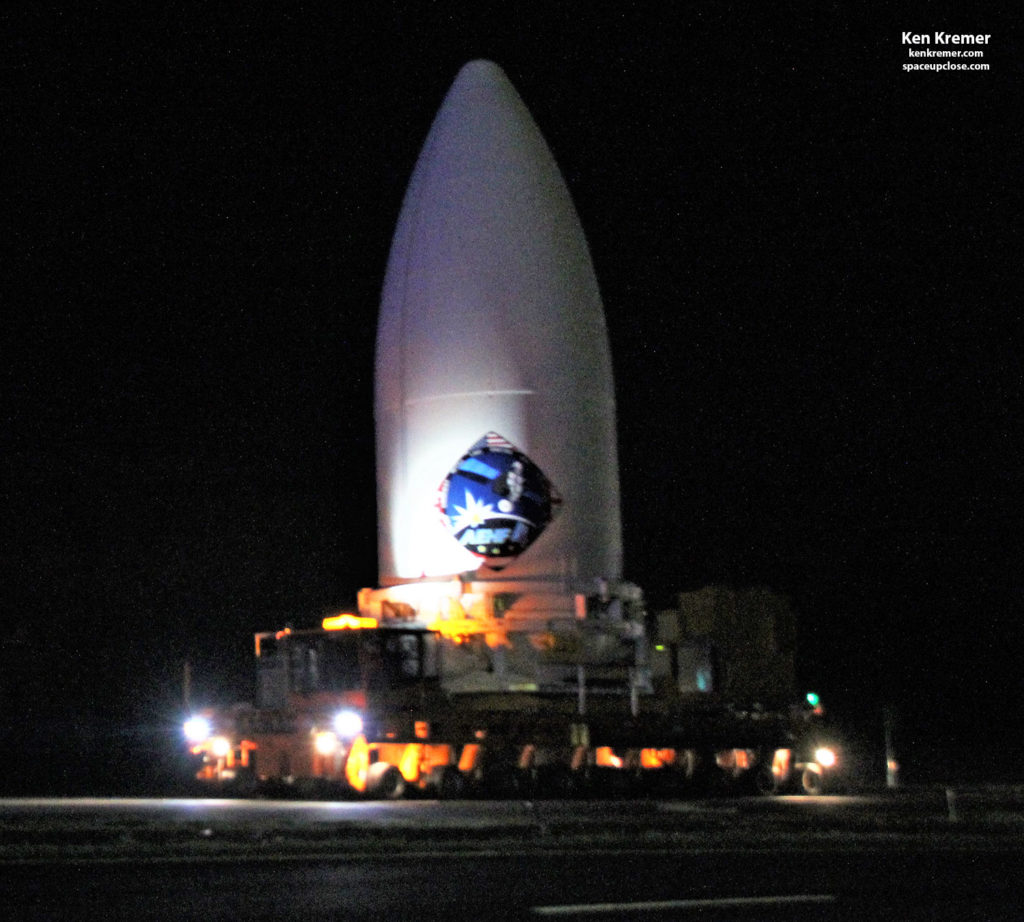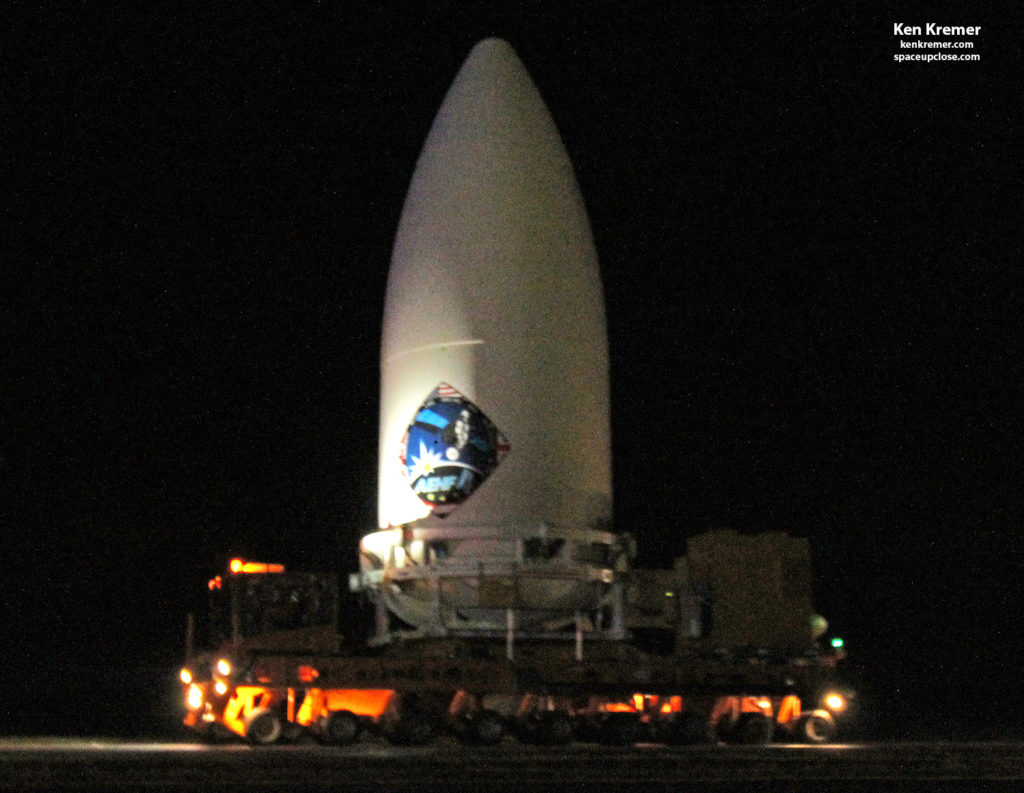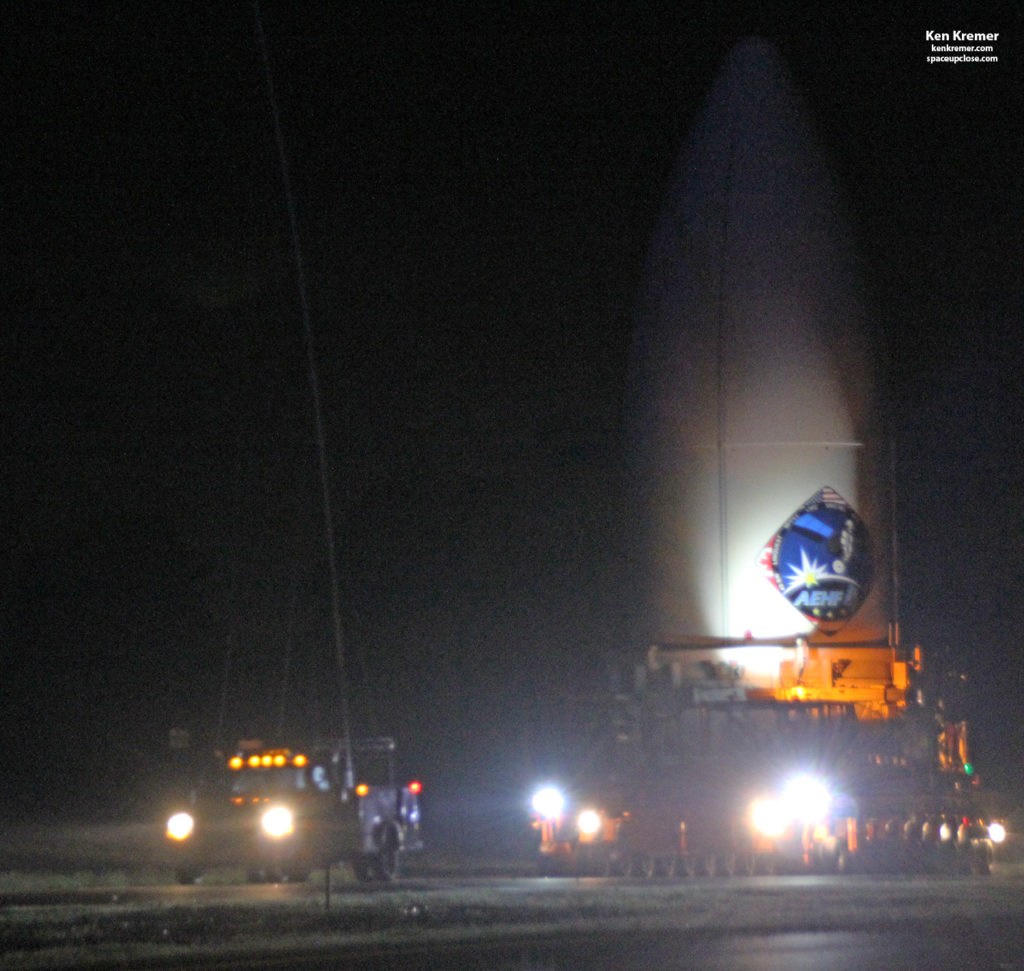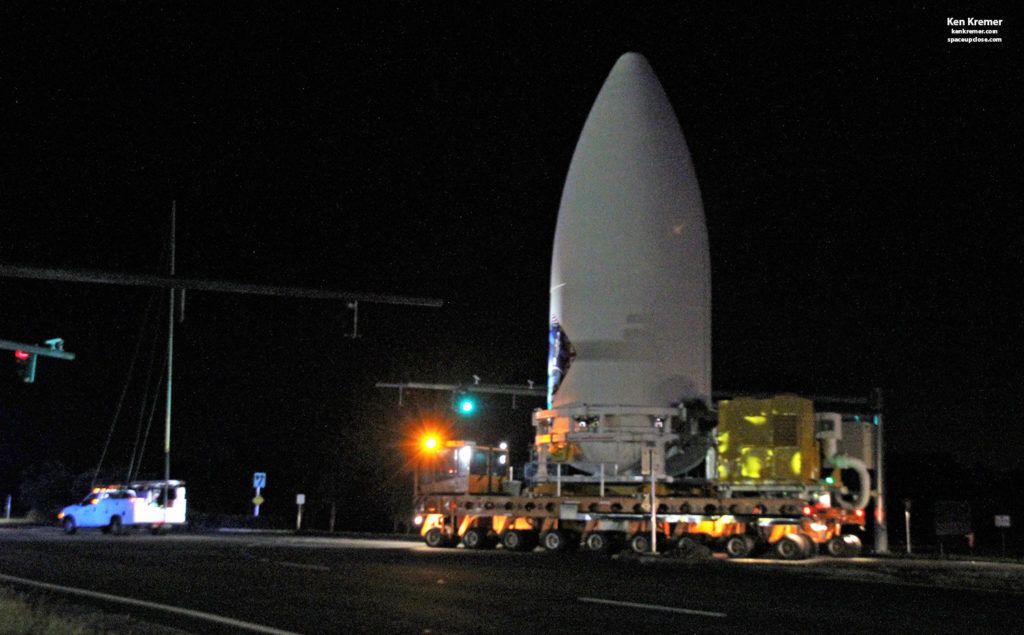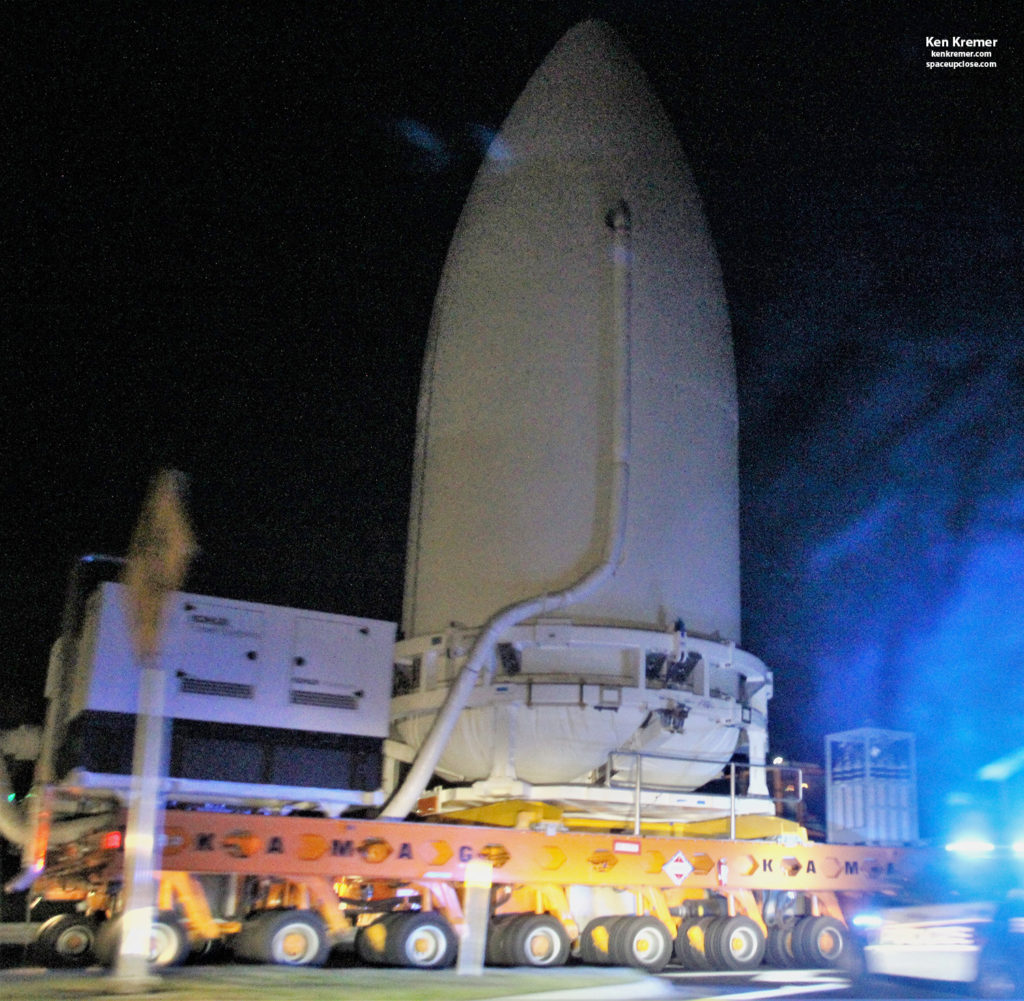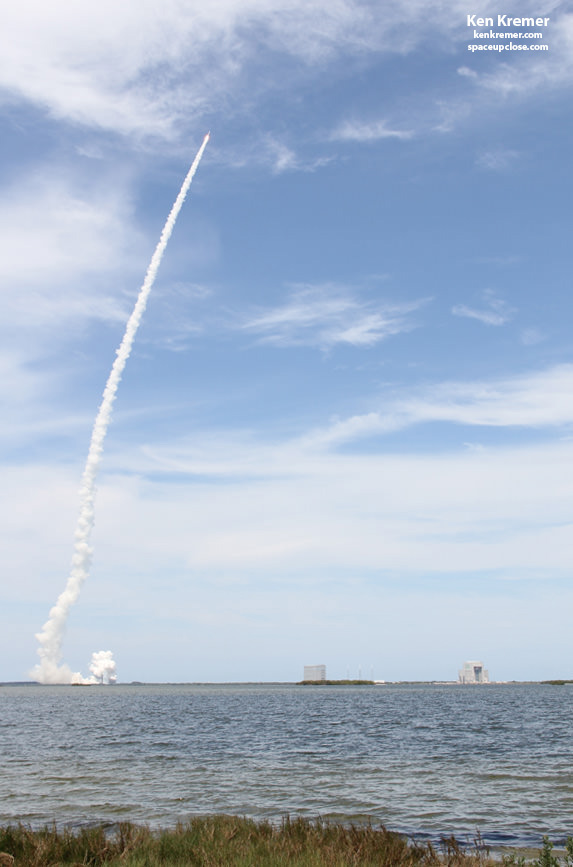Ken Kremer
— SpaceUpClose.com — 6 October 2018
TITUSVILLE, FL – The newest
and most advanced US Air Force jam-resistant protected military communications
satellite – named AEHF-4 and vital for U.S. national security – rolled out from a
Titusville processing facility to its Cape Canaveral launch pad in the dead of
night Friday Oct. 5 for integration with the mighty United Launch Alliance (ULA)
Atlas V rocket that will propel it to geostationary orbit (GEO) later this
month from the Florida Space Coast on October 17.
ULA will use the most powerful variant of their workhorse Atlas
V rocket in the 551 configuration to launch the secure AEHF-4 milsatcom for Air
Force Space Command shortly after midnight on October 17 at 12:15 a.m. EDT from
Space Launch Complex-41 on Cape Canaveral Air Force Station, FL.
AEHF-4 is the fourth communications satellite in the Advanced
Extremely High Frequency (AEHF) series for U.S. Air Force Space Command.
For the move to the Cape, the AEHF-4 milsatcom was mounted atop the
Centaur upper stage and encapsulated by technicians in a RUAG Space built short payload
fairing (PLF) – approximately 5.4 meters (17-feet) in diameter and 20.7 meters
(68-feet) tall, and secured atop a multi-wheeled, yellow colored KAMAG
transporter inside the high bay at the Astrotech Space Operations processing
facility in Tiitusville, FL.
Check out my eyewitness gallery of Space UpClose photos as I observed
the AEHF-4 convoy travel along public locations on Rt. 405 towards the Cape.
enforcement escort vehicles on public roads to NASA’s Kennedy Space Center after
midnight in order to keep the hugely expensive satellite safe, avoid as much traffic
as possible and minimize interaction with and interruption to normal vehicular movements.
and tourists visiting the Kennedy Space Center and Visitor Complex and beyond to
NASA and Cape Canaveral Air Force Station launch pads and facilities.
The bright white payload fairing was emblazoned on one side with
the colorful AEHF-4 logo and made for quite a beautiful sight as the train of escort vehicles
passed by me slowly – set against the clear black night sky blazing brilliantly
with heavenly constellations under comfortable weather conditions.
RUAG in Bern and is made of a sandwich
composite structure made with a vented aluminum-honeycomb core and
graphite-epoxy face sheets. The two piece bisector shell encapsulates both the
Centaur second stage and the satellite.
After arriving at Space
Launch Complex-41 the encapsulated satellite will be integrated on top of the ULA
Atlas V rocket inside the Vertical Integration Facility.
global, highly secure, protected, and jam-resistant communications for
high-priority military ground, sea, and air assets, between
U.S. national leadership [meaning the President] and deployed military forces, says USAF Space Command.
The AEHF constellation “provides 10
times the throughput and a substantial increase in coverage compared to the
1990s-era Milstar satellites” that it replaces and are currently in orbit.
 |
|
Credit: Ken
Kremer/kenkremer.com/spaceupclose.com |
undergoing extensive final prelaunch processing in the Astrotech Space
Operations processing facility since arriving at Cape Canaveral Air Force
Station on July 27, to ensure its readiness for flight and ability to carry out
its critical mission in support of US national defense, according to a USAF
statement. It was flown aboard a C-5M
Super Galaxy aircraft from Travis Air Force Base, California.
contractor Lockheed Martin at the satellite integration facility in Sunnyvale,
California, based on the A 2100 series communications satellite spacecraft
model and has a mass of some 6100 kg (13600 pounds).
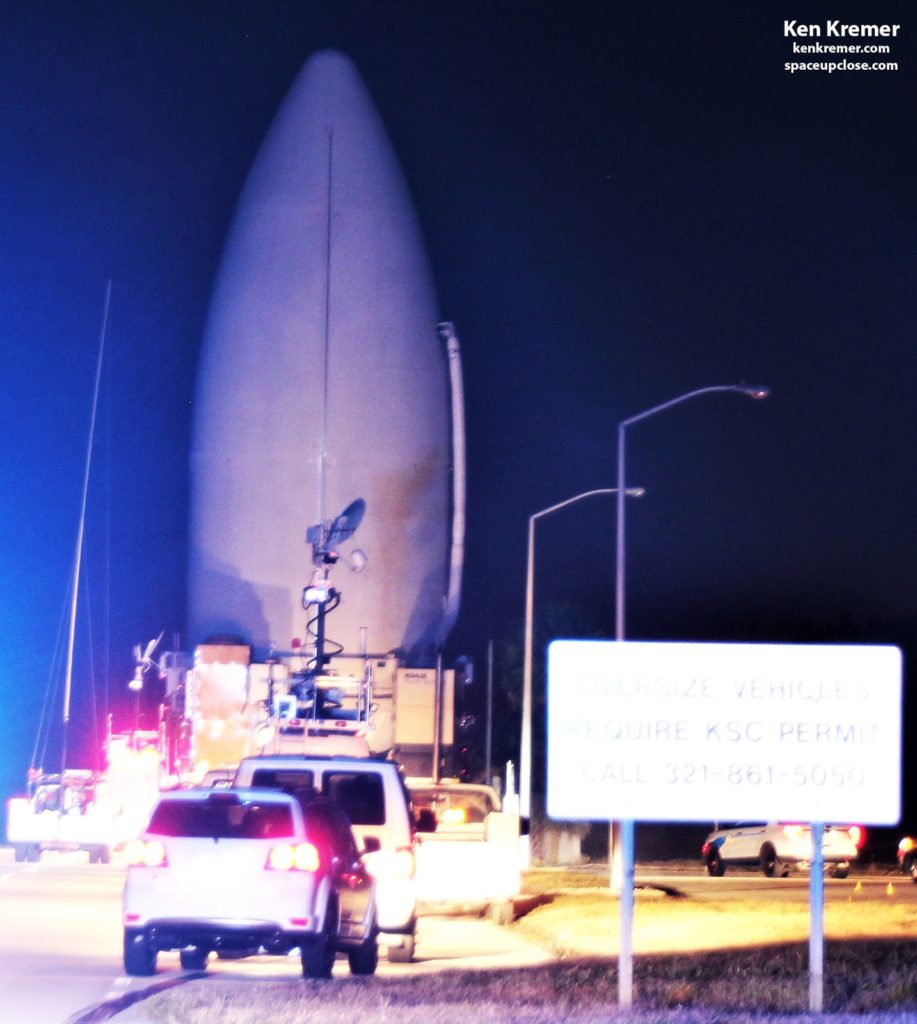 |
|
Credit: Ken
Kremer/kenkremer.com/spaceupclose.com |
marks a significant milestone in fulfilling our communication commitment to the
highest priority Department of Defense ground, sea, and air missions.
It’s an important asset for the warfighter and will be employed for years to
come,” said Lt. Gen. John Thompson, Space and Missiles Systems Center
commander and Air Force program executive officer for space, in a statement.
The processing work at
Astrotech by a combined government and contractor team includes “final ground
activities including a Launch Base Confidence Test to verify satellite
integrity after shipment, an intersegment test to verify communication
compatibility from the satellite to the ground operations center, and the final
battery reconditioning for launch.”
Furthermore, the satellite was fueled and
prepared for integration with the Atlas V launch vehicle at pad 41.
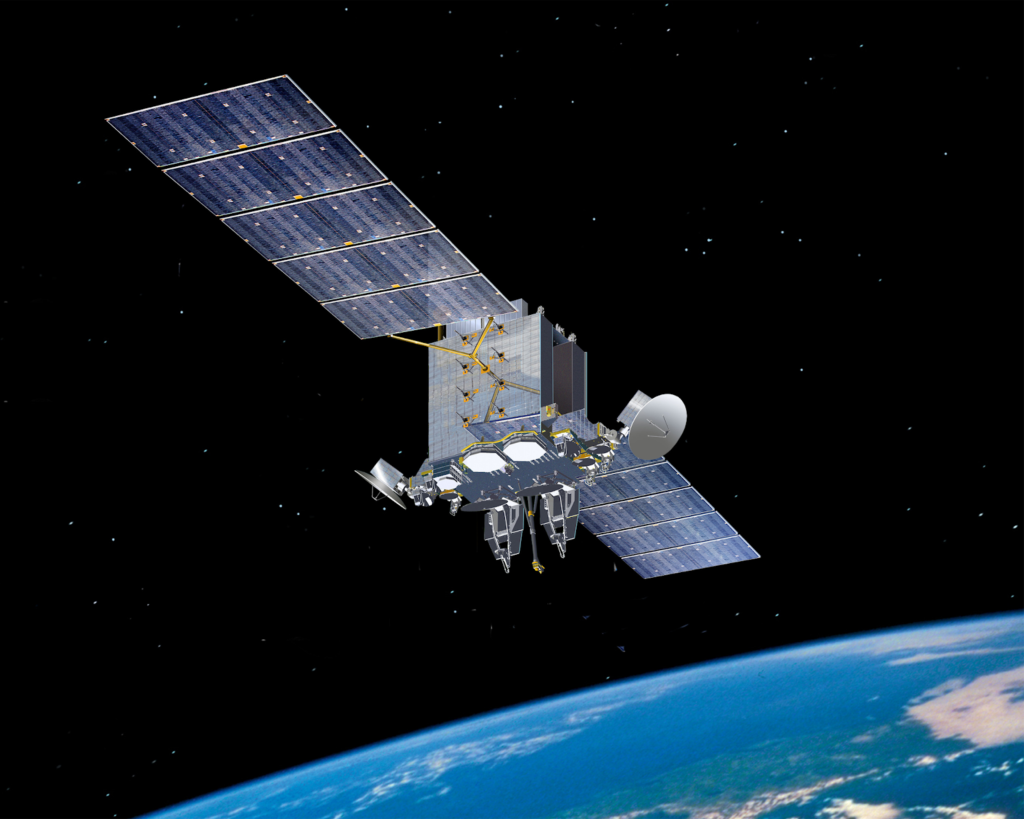 |
|
Artists concept of Advanced Extremely High
Frequency military communications satellite in orbit for US Air Force Space Command. Credit: USAF |
the existing constellation of three satellites launched earlier on ULA Atlas V
rockets; AEHF-1 in 2010, AEHF-2
in 2012 and AEHF-3 in 2013 – all utilizing the 531 configuration using 3 first
stage solid rocket boosters vs. 5 solids for AEHF-4.
The new satellite expands that
constellation of three Air Force Space Command AEHF satellites to four – operating
in geostationary orbit 22,300 miles (36000 kilometers) above Earth.
Two additional AEHF satellites
are under construction by
Lockheed Martin and are expected to launch starting in 2019 to round out the system
to a six-satellite constellation.
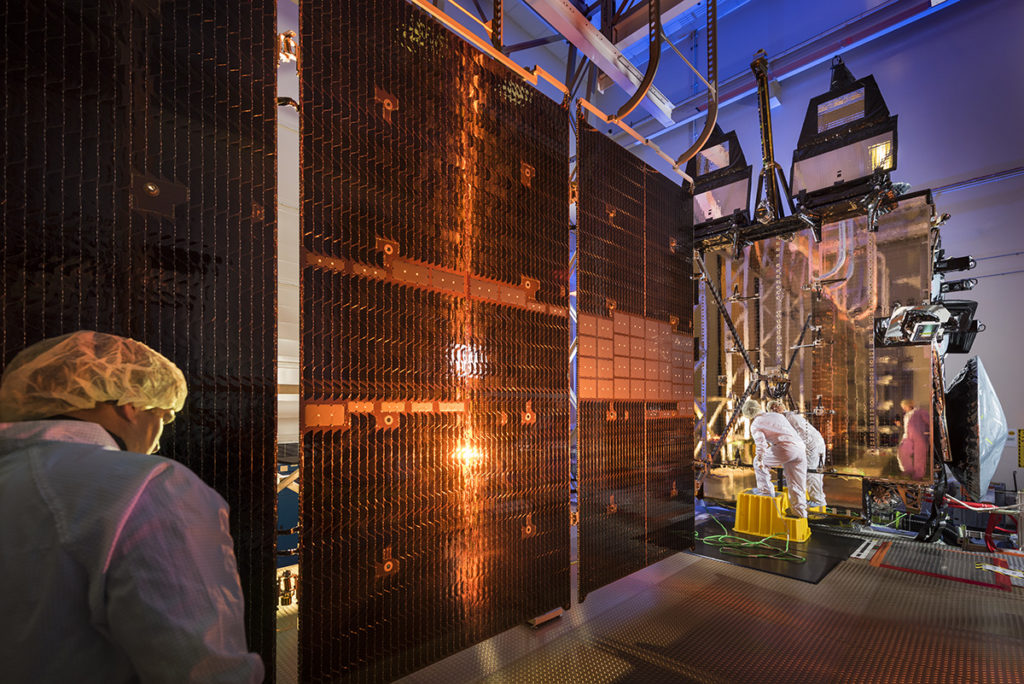 |
|
Lockheed Martin built and tested
the fourth AEHF satellite in Sunnyvale, California, before shipping it for launch on ULA Atlas V in October 2018. Two other satellites are in production. Credit: Lockheed Martin |
A major milestone was achieved with the first 3
AEHF satellites when the Initial Operational Capability (IOC) for the Advanced
Extremely High Frequency system was declared on July 28, 2015 by General John
Hyten, Air Force Space Command commander.
The Air Force’s 4th Space Operations Squadron operates the AEHF
system, supporting warfighters around the world.
It provides
continuous 24-hour coverage between 65 degrees north and 65 degrees south
latitude.
The AEHF satellites are
equipped with 2 SHF Downlink Phased Arrays, 2 Crosslinks, 2 Uplink/Downlink
Nulling Antennas, 1 Uplink EHF Phased Array, 6 Uplink/Downlink Gimbaled
Dish Antenna, 1 Each Uplink/downlink earth coverage horns.
The data rate capability
ranges from 75 bps to approximately 8 Mbps.
The AEHF system includes
international partners from the United Kingdom, Canada and the Netherlands.
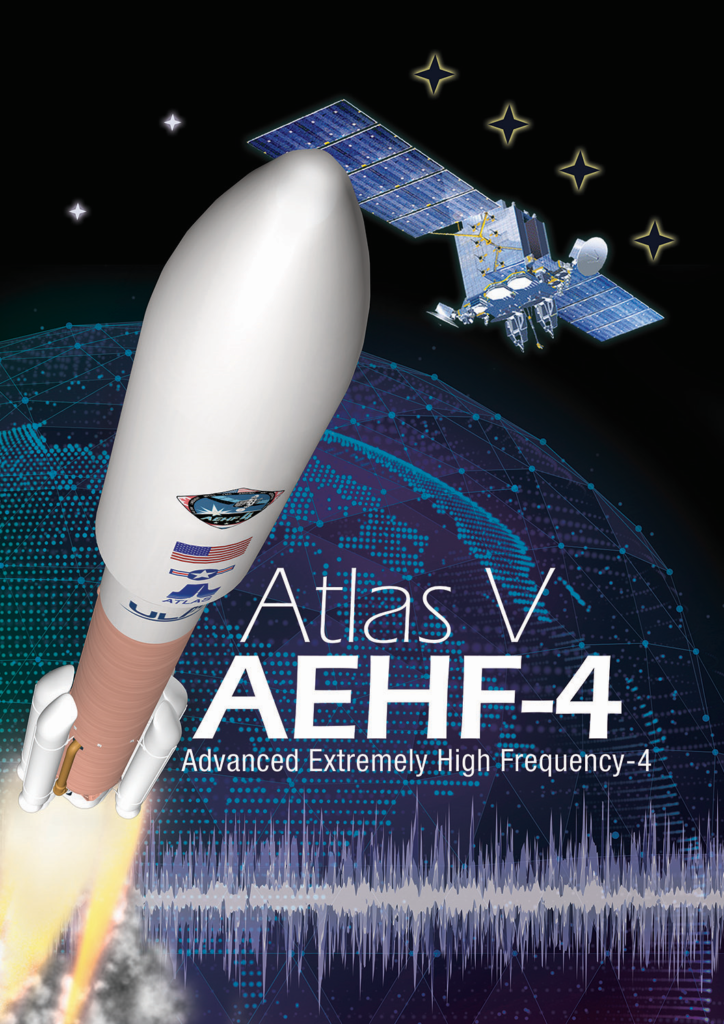 |
|
Advanced Extremely High Frequency-4 launch
poster on United Launch Alliance Atlas V rocket. Credit: United Launch Alliance |
continuing onsite coverage of NASA, SpaceX, ULA, Boeing, Lockheed Martin,
Orbital ATK and more space and mission reports direct from the Kennedy Space
Center, Cape Canaveral Air Force Station, Florida and Wallops Flight Facility,
Virginia.
Stay tuned here for Ken’s continuing Earth and Planetary science
and human spaceflight news: www.kenkremer.com –www.spaceupclose.com –
twitter @ken_kremer – email: ken at kenkremer.com
Dr. Kremer is a research
scientist and journalist based in the KSC area.
………….
Ken’s photos are for sale and he is available for lectures and outreach events
Ken’s upcoming outreach events/photos for
sale:
Learn more about the upcoming upcoming/recent ULA/USAF AEHF-4 milsatcom, NASA/ULA Parker Solar
Probe, SpaceX Merah Putih & Telstar 18 & 19 launches, SpaceX Falcon
9/CRS-15 launch to ISS, Falcon Heavy, NASA TESS, GOES-S, NASA missions,
ULA Atlas & Delta launches, SpySats and more at Ken’s upcoming outreach
events at Kennedy Space Center Quality Inn, Titusville, FL, evenings.
Oct 13, 15-17: “ULA/USAF AEHF-4 milsatcom, NASA/ULA Parker
Solar Probe launch, SpaceX Merah Putih & Telstar 18v & 19v Launches,
SpaceX Dragon CRS-15 resupply launch to ISS, SpaceX Falcon Heavy & Falcon 9
launches, SpaceX SES-12 comsat. ULA Atlas USAF SBIRS GEO 4 missile warning
satellite, NRO & USAF Spysats, SLS, Orion, Boeing and SpaceX Commercial
crew capsules, OSIRIS-Rex, Juno at Jupiter, InSight Mars lander, Curiosity and
Opportunity explore Mars, NH at Pluto and more,” Kennedy Space Center Quality
Inn, Titusville, FL, evenings. Photos for sale


